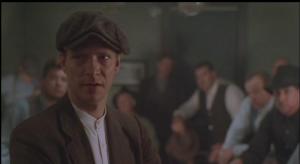Matewan is a 1987 film directed by John Sayles. It deals with the Matewan Massacre (or the “Battle of Matewan”) when coal miners in West Virginia attempted to unionize and ran into significant resistance from the owners of the mines. The film deals with themes of the division of the working class along racial lines, working class direct action, and capital’s resistance to worker organization. Chris Cooper plays the main character who is a union organizer and former Wobblie. He seems a bit disillusioned with the labor movement in its lack to truly form “One Big Union.” He arrives in Matewan on the same train that was breaking in black strike-breakers to replace the striking miners when the train stops and he witnesses the black strike-breakers beaten by racists on the way to town.

Cooper's character gives an anti-racist speech
Once he gets to town, he slowly tries to network and get in touch with the union where he tries to convince them to stand united with the workers coming to break the strike, while also convincing the strike-breakers that they ought not put the mine back in operation. This drama is highlighted in a scene where the “leader” of the black strike breakers comes to a meeting of the union and demonstrates that he is “no scab.” Cooper’s character gives a powerful speech denouncing the racism of the union and how workers need to stand together if they are to win their struggle against the company and the bosses. The visiting workers who were brought in to break the strike decide to stand in solidarity with the original workers and eventually join the strike to add more pressure on the company and thus make the strike more effective. This is what the rest of the film focuses on, the ongoing class struggle between the mine workers and the owners while the owners try various tactics of manipulating the workers (such as using agent provocateurs, lies, etc.) into defeat and ultimately fail (at least in the context of the film, historically the workers initially failed). The film ends with a major battle in the middle of the town that results in a few deaths, including Coopers character, yet the mood of the post-battle scene is that of optimism.
Where Sayles leaves this historical narrative off is of is incomplete with the actual struggles of mineworkers in WVA at the time. The “Battle of Matewan” lead almost directly to a larger, bloodier and more historically significant battle commonly known as the “Battle of Blair Mountain.” This battle involved the United Mine Workers of America who had been on strike and were involved with the Matewan incident and state and federal troops and is considered the largest labor uprising in US history (although it is not commonly taught in US schools). Sayles ends his story before this event took place, perhaps because he wished to leave on a positive note since the Battle for Blair Mountain resulted in a major defeat for UMWA. Although, many consider the labor laws passed in the 30s (and thus the resurgence of the labor movement) to be either directly or indriectly a result of the Battle of Blair Mountain, as the power that were in society at the time were backing the New Deal and attempting to avoid any sort of workers revolution (which at that time, was not an unrealistic possibility). Overall, Matewan is certainly a film worth watching as it portrays a chapter in US labor history that is often skipped over and forgotten.

Pingback: Documentary a Day: Mine War on Blackberry Creek (1986) « Waiting for Lefty
Pingback: Harlan County, USA (1976) « Left Film Review